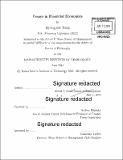Essays in financial economics
Author(s)
Kang, Hyungjune
DownloadFull printable version (10.02Mb)
Other Contributors
Sloan School of Management.
Advisor
Andrey Malenko.
Terms of use
Metadata
Show full item recordAbstract
This thesis consists of three chapters. In the first chapter, I analyze a dynamic game in which a sender of unknown quality persuades a receiver by designing an experiment (model) that transforms signals into recommendations (messages). When the receiver learns the sender's quality by observing the sender's past recommendations and realized events, I show that, due to reputational concern, the sender chooses an experiment that limits the amount of information. A more patient sender is less likely to devise an informative experiment. I also demonstrate that the quality of the sender-optimal experiment-measured by the amount of information-is not monotonic in the sender's quality. The framework can be applied to various settings including financial regulation and analyst forecasting. In the second chapter, based on joint work with Tetsuya Kaji, we study how Value-at- Risk (VaR) constraint affects the amount of information that price conveys in an economy with asymmetric information. We first show that VaR constraint is different from others (e.g. borrowing and short-sale constraints) in that VaR constraint is relevant only when price is moderate. We find that when some investors follow a VaR rule, realistically high or low prices reveal more information than intermediate prices. We illustrate how the presence of VaR investors affects other investors' incentive to acquire information. In the third chapter, based on joint work with Tetsuya Kaji, we propose a class of risk measures called the tail risk measures that establish the upper bounds below which the quantities of interest fall with probability at least as much as a pre-specified confidence level. We show that a simple rule based on the Bonferroni inequality can control a tail risk measure at a desired level even when the true risk is unknown and needs to be estimated. Most popular risk measures such as Value-at-Risk and expected shortfall are interpreted as tail risk measures. Empirical applications illustrate how the proposed concept can be applied to practical risk control problems.
Description
Thesis: Ph. D., Massachusetts Institute of Technology, Sloan School of Management, 2018. Cataloged from PDF version of thesis. Includes bibliographical references.
Date issued
2018Department
Sloan School of ManagementPublisher
Massachusetts Institute of Technology
Keywords
Sloan School of Management.